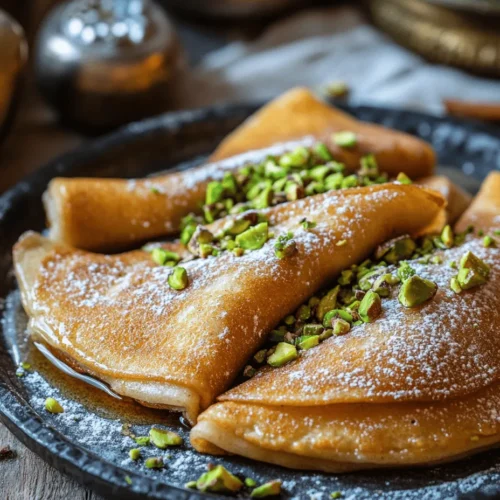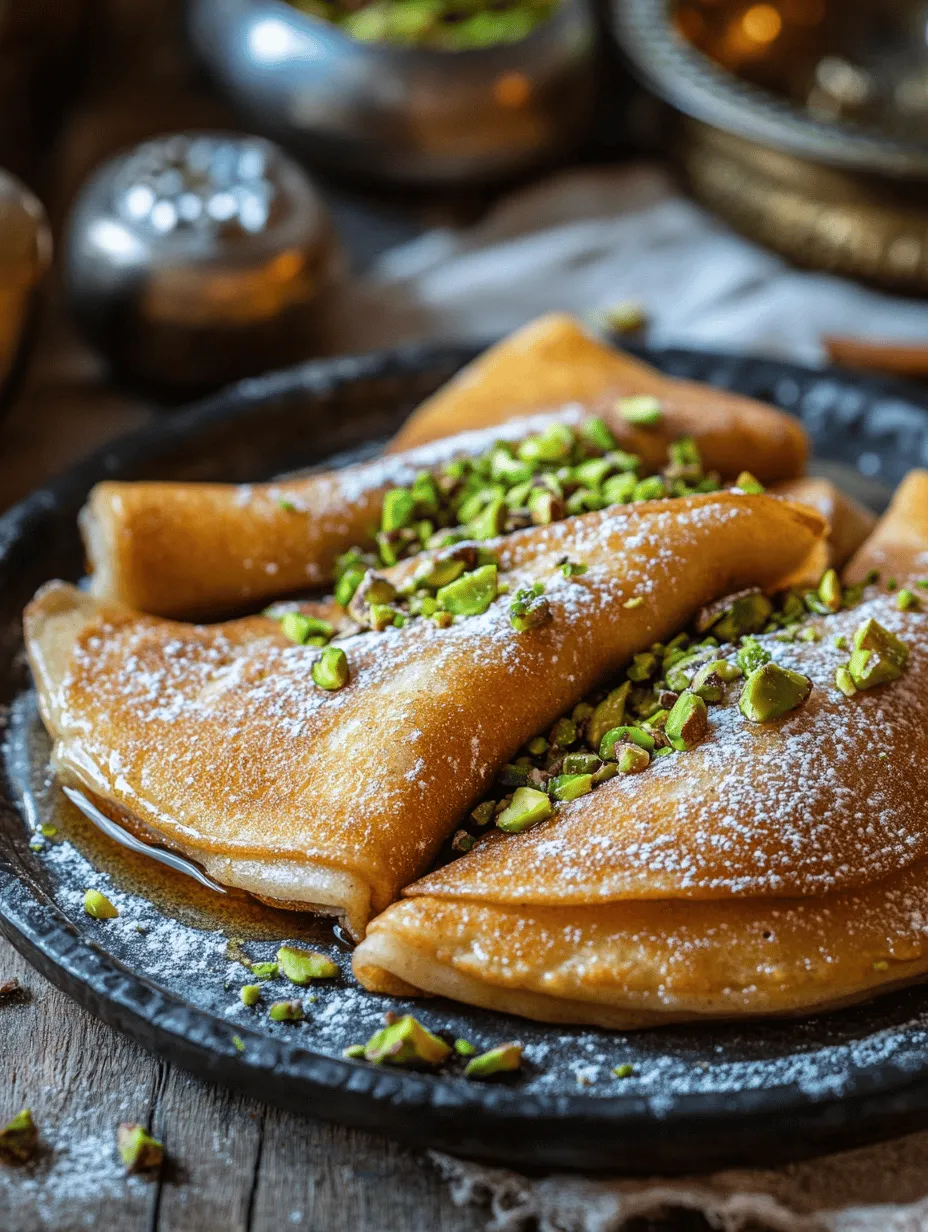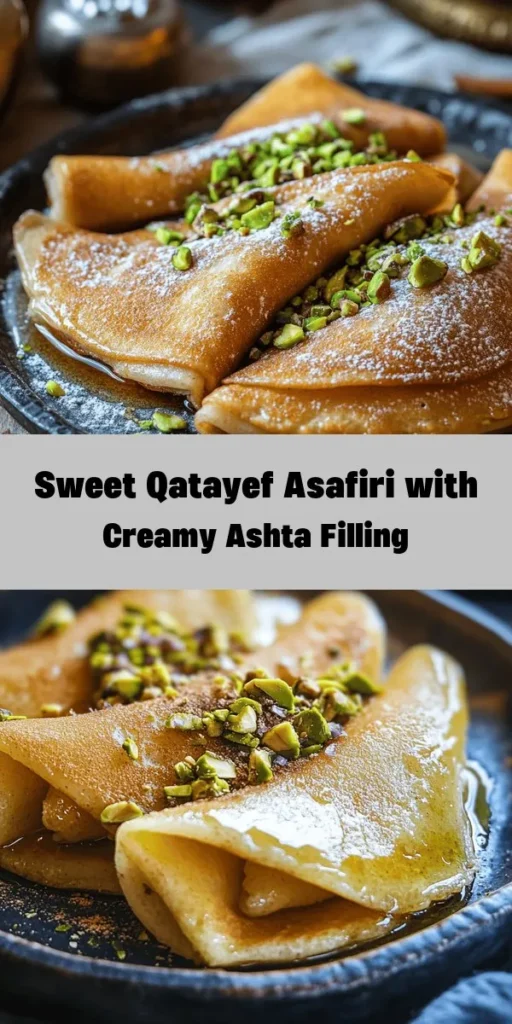Introduction to Qatayef Asafiri with Ashta: A Delicious Middle Eastern Dessert
Qatayef Asafiri, a beloved Middle Eastern dessert, embodies the rich culinary tapestry of the region. This delightful treat has transcended generations and cultural boundaries, making it a staple during festive occasions, particularly Ramadan. With its origins deeply rooted in Middle Eastern traditions, Qatayef Asafiri is not just a dessert; it is a symbol of celebration, hospitality, and the joy of sharing sweet moments with family and friends.
The appeal of Qatayef Asafiri lies in its harmonious blend of textures and flavors. Imagine pancake-like dough, expertly cooked to achieve a tender yet sturdy base, filled with a luscious cream known as Ashta, and drizzled with fragrant syrup. Each bite offers a delightful contrast: the gentle chewiness of the dough paired with the rich creaminess of the filling, all enhanced by the sweetness of the syrup. This dessert is not only a feast for the palate but also for the eyes, with its delicate presentation making it a centerpiece at any gathering.
In a world where mass-produced treats often overshadow homemade delights, the joy of preparing traditional recipes like Qatayef Asafiri becomes even more significant. Crafting this dessert from scratch allows you to connect with your culinary heritage, infusing your kitchen with delightful aromas and flavors. Whether you are sharing it with loved ones or enjoying it as a personal indulgence, making Qatayef Asafiri is an experience filled with pride and satisfaction.
The Allure of Qatayef Asafiri
Qatayef Asafiri is particularly popular during the holy month of Ramadan, where it is often served as a tantalizing dessert to break the fast. The process of making Qatayef is itself a social activity, frequently involving family members who gather to prepare this treat together, creating cherished memories in the kitchen. Its significance during Ramadan is not just about the dessert; it’s also about the traditions that accompany it, where food becomes a medium for connection and celebration.
Across the Middle East, variations of Qatayef exist, each reflecting the unique culinary influences of different cultures. In some regions, you may find Qatayef stuffed with nuts or cheese, while others prefer the classic Ashta filling. Regardless of the variation, one thing remains constant: the delightful experience of savoring a freshly made Qatayef, often served warm and generously topped with syrup.
The textures and flavors of Qatayef Asafiri set it apart from ordinary desserts. The dough, when cooked correctly, achieves a perfect balance between softness and resilience, allowing it to cradle the creamy Ashta filling without tearing. The Ashta itself is a rich, velvety cream, infused with subtle flavors such as rose water or orange blossom, which elevate the overall taste profile. Finally, the syrup adds a sweetness that ties everything together, creating a dessert that is as comforting as it is indulgent.
Ingredients Breakdown: Understanding the Components of Qatayef Asafiri
To create the perfect Qatayef Asafiri, it is essential to understand the role of each ingredient in the recipe. Each component contributes to the overall texture and flavor, ensuring that your dessert is nothing short of exceptional.
Essential Ingredients
1. All-Purpose Flour and Semolina: These two ingredients form the foundation of the Qatayef batter. The all-purpose flour provides the necessary gluten structure, giving the dough its elasticity, while the semolina adds a delightful graininess and contributes to the overall texture.
2. Sugar: Sugar is crucial for balancing the flavors in both the dough and syrup. It not only adds sweetness but also helps to achieve the desired browning when cooking the Qatayef.
3. Baking Powder: This leavening agent is essential for achieving the right fluffiness in the dough. It reacts with the wet ingredients, creating air pockets that make the Qatayef light and airy.
4. Rose Water: A staple in Middle Eastern desserts, rose water enhances the flavors and adds a fragrant aroma to the batter. Just a hint is enough to elevate the overall taste of the Qatayef.
5. Heavy Cream: The Ashta filling is primarily made from heavy cream, which provides a rich and indulgent texture. The cream is cooked to achieve the perfect thickness, ensuring it holds its shape when filled into the Qatayef.
The Role of Each Ingredient
Understanding the role of these ingredients is crucial for achieving the perfect Qatayef Asafiri. The combination of all-purpose flour and semolina gives the dough its unique texture, while sugar balances the flavors. The baking powder ensures the dough rises correctly, creating a soft and pillowy base. Rose water not only adds flavor but also enhances the aromatic experience of enjoying this dessert. Finally, heavy cream is essential for the Ashta filling, providing a luxurious creaminess that complements the dough beautifully.
Preparing the Qatayef Batter
Creating the batter for Qatayef is a straightforward process, but attention to detail is essential to achieving the desired texture and flavor. Here’s a step-by-step guide on how to prepare the batter:
Step 1: Mixing the Dry Ingredients
In a large mixing bowl, combine the all-purpose flour, semolina, sugar, and baking powder. Whisk the ingredients together until well blended. This ensures that the baking powder is evenly distributed, which is crucial for achieving consistent results in the cooking process.
Step 2: Adding the Wet Ingredients
Gradually add warm water to the dry ingredients while stirring continuously. The warm water helps to activate the baking powder, leading to a better rise in the dough. Continue mixing until the batter is smooth and free of lumps. The consistency should be similar to that of pancake batter — thick but pourable.
Step 3: Incorporating Flavors
Once the batter is well mixed, add the rose water. Stir gently to incorporate the flavor without overmixing the batter. Allow the batter to rest for at least 30 minutes. This resting period is crucial as it allows the gluten in the flour to relax, resulting in a more tender and pliable dough.
Step 4: Cooking the Qatayef
After resting, heat a non-stick skillet or griddle over medium heat. Lightly grease the surface with a small amount of oil or butter. Pour a scoop of batter onto the skillet, forming small circles about 3-4 inches in diameter. Cook until bubbles form on the surface and the edges appear set, usually around 2-3 minutes. Do not flip the Qatayef; they should be cooked only on one side. Remove from the skillet and place the cooked Qatayef on a clean towel to cool.
Tips for Optimal Texture
– Resting the Batter: Do not skip the resting period, as it significantly improves the texture of the Qatayef.
– Temperature Control: Ensure your skillet is at the right temperature. Too hot, and the Qatayef will burn; too cool, and they will not cook through properly.
– Consistency: If your batter seems too thick after resting, you can add a little more water to achieve the desired pourable consistency.
Creating the Ashta Cream Filling
The Ashta filling is the heart of Qatayef Asafiri, providing a luxurious contrast to the pancake-like dough. Making Ashta requires careful attention to temperature and technique. Here’s how to prepare it:
Step 1: Cooking the Cream
In a medium saucepan, combine the heavy cream and sugar. Heat over medium-low heat, stirring frequently to dissolve the sugar completely. It’s important to avoid high heat at this stage, as it can cause the cream to scorch.
Step 2: Thickening the Ashta
Once the mixture is warm, gradually sprinkle in cornstarch while continuously stirring. This will help to thicken the cream as it cooks. Continue to stir until the mixture thickens to a custard-like consistency, which usually takes about 5-7 minutes.
Step 3: Flavoring the Filling
Once thickened, remove the saucepan from heat and stir in rose water for flavor. Adjust the amount according to your preference — the goal is to enhance the creaminess without overpowering it with floral notes.
Step 4: Cooling the Ashta
Transfer the Ashta to a bowl and cover it with plastic wrap, pressing the wrap directly against the surface to prevent a skin from forming. Allow it to cool completely at room temperature before assembling the Qatayef. If you’re in a hurry, you can place the bowl in the refrigerator to speed up the cooling process.
Achieving the Right Thickness and Flavor
The key to a perfect Ashta filling lies in the cooking process. Maintaining a gentle heat will allow the cream to thicken gradually without curdling. Stirring consistently helps to incorporate air, resulting in a light and creamy filling. The cooling process is equally important; ensuring the Ashta is cold before assembly will prevent it from melting the Qatayef dough.
Crafting the Sugar Syrup
A sweet syrup is the finishing touch that elevates Qatayef Asafiri from delicious to extraordinary. Here’s how to make the classic sugar syrup that complements this dessert perfectly:
Ingredients for Sugar Syrup
– 2 cups sugar
– 1 cup water
– 1 tablespoon lemon juice
– 1 teaspoon rose water (optional)
Step 1: Mixing the Ingredients
In a saucepan, combine the sugar and water. Stir over medium heat until the sugar dissolves completely.
Step 2: Boiling the Syrup
Once the sugar is dissolved, bring the mixture to a gentle boil. Allow it to boil for about 10 minutes without stirring. This will help the syrup thicken.
Step 3: Adding Flavor
After boiling, remove the saucepan from heat and stir in the lemon juice. This helps to balance the sweetness and prevents the syrup from crystallizing. If you desire an aromatic touch, add rose water for a fragrant finish.
Step 4: Cooling the Syrup
Let the syrup cool completely before using it on your Qatayef. It will thicken slightly as it cools, achieving the perfect consistency for drizzling.
With these steps completed, you are well on your way to crafting a delectable Qatayef Asafiri with Ashta. The combination of tender dough, rich cream filling, and sweet syrup will undoubtedly impress anyone lucky enough to taste this Middle Eastern delicacy. Stay tuned for the next part, where we will delve into the assembly of the Qatayef and the final touches that make this dessert truly special.

Importance of Sugar Syrup in Middle Eastern Desserts
Sugar syrup, known as “attar” in Arabic, is a quintessential component of many Middle Eastern desserts, including Qatayef Asafiri. This syrup not only enhances sweetness but also adds a glossy finish and helps to balance the flavors of rich, creamy fillings. The syrup acts as a binding agent for various ingredients, ensuring that each bite is infused with sweetness while also providing moisture to the dessert. As a versatile element, sugar syrup can be flavored with various ingredients like rose water, orange blossom, or even vanilla, allowing for a personalized touch that can elevate the overall experience of the dish.
Step-by-Step Process to Make the Syrup
1. Ingredients Needed:
– 2 cups granulated sugar
– 1 cup water
– 1 teaspoon lemon juice
– Optional: 1 tablespoon of rose water or orange blossom water for flavor
2. Cooking Instructions:
– In a medium saucepan, combine the sugar and water.
– Place the saucepan over medium heat and stir gently until the sugar is completely dissolved.
– Once dissolved, bring the mixture to a boil.
– Add the lemon juice, which helps prevent crystallization and adds a slight tartness to balance the sweetness.
– Allow the syrup to boil for about 10 minutes, until it thickens slightly. Keep in mind that the syrup will thicken further as it cools.
– If desired, add rose water or orange blossom water after removing the syrup from heat for a fragrant touch.
– Let the syrup cool to room temperature before using. Store any leftovers in an airtight container in the refrigerator for up to a month.
3. Tips for Adjusting Flavor and Consistency:
– If you prefer a less sweet syrup, you can reduce the sugar by up to 25% without compromising the overall texture.
– For a more intense flavor, consider infusing the syrup with spices like cinnamon or cardamom during cooking. Just strain them out before storing.
Cooking the Qatayef: Techniques for Perfect Pancakes
1. Instructions for Cooking:
– Preheat a non-stick skillet or griddle over medium heat. Lightly grease the surface with oil or cooking spray.
– Pour about 1/4 cup of the Qatayef batter onto the skillet for each pancake, spreading it into a round shape. Ensure that the pancakes are not too thick; they should be about 1/4 inch in thickness.
– Cook the pancakes for about 2-3 minutes until small bubbles appear on the surface, and the edges start to look dry.
2. Tips for Recognizing When the Pancakes Are Perfectly Cooked:
– The pancakes are ready to flip when the top is set and there are no wet areas. Avoid flipping them, as Qatayef are typically cooked only on one side.
– Once cooked, remove them from the pan and place them on a clean kitchen towel or a plate. Cover them immediately with another towel to keep them warm and pliable for easy filling.
3. Importance of Covering the Pancakes:
– Keeping the pancakes covered is crucial as it prevents them from drying out. This ensures they remain soft and flexible, making it easier to fill and seal without breaking.
Assembling the Qatayef: Filling and Sealing
1. Detailed Instructions:
– Once the pancakes have cooled slightly, take one and place it in the palm of your hand or on a clean surface.
– Spoon a generous tablespoon of Ashta (Middle Eastern clotted cream) into the center of the pancake.
– Fold the pancake in half, aligning the edges, and pinch them together firmly to seal. Ensure there are no gaps, as this can cause the filling to leak during cooking.
2. Importance of Ensuring a Tight Seal:
– A tight seal is essential for keeping the filling secure and preventing it from leaking out during cooking. This ensures that each bite is filled with the creamy goodness of Ashta.
3. Suggestions for Presentation and Garnishing:
– Arrange the filled Qatayef on a serving platter. Drizzle with your prepared sugar syrup and garnish with chopped pistachios or a sprinkle of ground cinnamon for added flavor and visual appeal.
Optional Frying for Added Texture
1. Explanation of the Optional Frying Step:
– While Qatayef can be enjoyed as is, frying them adds a delightful crunch that contrasts beautifully with the creamy filling. This step is optional, but highly recommended for those looking for an extra layer of texture.
2. Tips for Frying the Qatayef Safely:
– Heat about 1-2 inches of vegetable oil in a deep frying pan over medium heat until it reaches 350°F (175°C).
– Once the oil is hot, carefully add the sealed Qatayef in small batches. Fry them for about 2-3 minutes on each side until golden brown and crispy.
– Use a slotted spoon to remove the Qatayef from the oil and place them on paper towels to drain excess oil.
3. Discussing the Contrast:
– Fried Qatayef offers a delightful crunch that complements the creaminess of the Ashta, while the un-fried version emphasizes the softness of the pancakes. Depending on your preference, you can enjoy either style or even a mix of both.
Serving Suggestions and Presentation Ideas
1. Creative Ways to Serve Qatayef Asafiri:
– Present your Qatayef on a decorative platter, drizzled with warm sugar syrup and generously topped with crushed pistachios. A sprinkle of ground cinnamon adds an aromatic touch.
– For an elegant touch, serve Qatayef with a side of sugar syrup in small bowls for dipping or drizzling.
2. Discussion on Garnishing:
– Chopped pistachios not only add a vibrant color contrast but also a nutty flavor that pairs beautifully with the sweet Ashta. Ground cinnamon can enhance the overall flavor profile, inviting guests to indulge in this traditional dessert.
Cultural Significance and Variations of Qatayef
1. Exploration of How Qatayef is Enjoyed:
– Qatayef is often associated with Ramadan, where it is served during Iftar, the evening meal breaking the fast. Its rich flavors and satisfying texture make it a popular choice for celebrations and family gatherings.
2. Discussion of Regional Variations:
– Different regions have their unique twists on Qatayef. In Lebanon, for instance, they may use a mixture of nuts for the filling, while in Egypt, the pancakes might be served with a drizzle of honey instead of sugar syrup.
3. Significance of Sharing Food:
– In Middle Eastern culture, food represents hospitality and generosity. Preparing and sharing Qatayef Asafiri is not just about enjoying a sweet treat; it’s about connecting with family and friends, creating lasting memories through shared culinary experiences.
Conclusion: The Joy of Making Qatayef Asafiri
In summary, Qatayef Asafiri is a delightful dessert that encapsulates the essence of Middle Eastern hospitality and tradition. From the careful preparation of the sugar syrup to the meticulous assembly of the pancakes, each step is a labor of love that culminates in a treat that is both visually stunning and deliciously satisfying. The experience of making Qatayef Asafiri at home not only allows for customization and creativity but also fosters a deeper connection to the rich culinary heritage of the Middle East.
As you embark on this culinary journey, remember that cooking is not just about the end result but also about the joy of creating and sharing. So gather your loved ones, roll up your sleeves, and enjoy the process of making and savoring Qatayef Asafiri, a dish that brings people together and celebrates the beauty of tradition.



